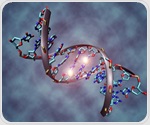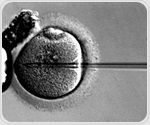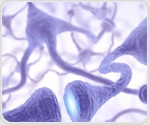| | Researchers long have known that some portion of the risk of developing cancer is hereditary and that inherited genetic errors are very important in some tumors but much less so in others. | |
|
| |  After a decade-long $3 billion international effort, scientists heralded the 2001 completion of the human genome as a moon landing achievement for biology and the key to finally solving intractable diseases like cancer. After a decade-long $3 billion international effort, scientists heralded the 2001 completion of the human genome as a moon landing achievement for biology and the key to finally solving intractable diseases like cancer. | |
|
| |  Whitehead Institute researchers have created a map of the DNA loops that comprise the three dimensional (3D) structure of the human genome and regulate gene expression in human embryonic stem (ES) cells and adult cells. The location of genes and regulatory elements within this chromosomal framework could help scientists better navigate their genomic research, establishing relationships between mutations and disease development. Whitehead Institute researchers have created a map of the DNA loops that comprise the three dimensional (3D) structure of the human genome and regulate gene expression in human embryonic stem (ES) cells and adult cells. The location of genes and regulatory elements within this chromosomal framework could help scientists better navigate their genomic research, establishing relationships between mutations and disease development. | |
|
| |  The presence or absence of the CAP2 gene causes sudden cardiac death in mice, according to new research from the Perelman School of Medicine at the University of Pennsylvania. In particular, the absence of the gene interrupts the animal's ability to send electrical signals to the heart to tell it to contract, a condition called cardiac conduction disease. The presence or absence of the CAP2 gene causes sudden cardiac death in mice, according to new research from the Perelman School of Medicine at the University of Pennsylvania. In particular, the absence of the gene interrupts the animal's ability to send electrical signals to the heart to tell it to contract, a condition called cardiac conduction disease. | |
|
| | In recent decades much hope was based on the development of personalised drug treatments, in which genetic tests determine the choice and optimal dose of medication for each individual patient. | |
|
| |  Researchers reported promising preliminary outcomes for the first four children enrolled in a U.S. gene therapy trial for Wiskott-Aldrich syndrome (WAS), a life-threatening genetic blood and immune disorder, at the 57th annual meeting of the American Society of Hematology (abstract #260). Researchers reported promising preliminary outcomes for the first four children enrolled in a U.S. gene therapy trial for Wiskott-Aldrich syndrome (WAS), a life-threatening genetic blood and immune disorder, at the 57th annual meeting of the American Society of Hematology (abstract #260). | |
|
| |  Variations in genes involved in normal bone development are associated with an 8- to 15-fold increased risk for osteonecrosis in young patients with acute lymphoblastic leukemia (ALL), according to research led by St. Jude Children's Research Hospital and Children's Oncology Group investigators. Variations in genes involved in normal bone development are associated with an 8- to 15-fold increased risk for osteonecrosis in young patients with acute lymphoblastic leukemia (ALL), according to research led by St. Jude Children's Research Hospital and Children's Oncology Group investigators. | |
|
| |  Animal studies have already shown that a strong link exists between genetic background and physical activity level. The purpose of our study was to investigate the associations between genetic background, physical activity level, and lifespan. Animal studies have already shown that a strong link exists between genetic background and physical activity level. The purpose of our study was to investigate the associations between genetic background, physical activity level, and lifespan. | |
|
| | Pharmacogenomics is the field of study about the effect of genes on an individual’s response to medications. It combines the science of drugs, pharmacology, with the study of genes, genomics, to establish effective ways to use medications in respect to the genetic makeup of each individual. | |
|
| |  Scientists from Imperial College London have identified for the first time two clusters of genes linked to human intelligence. Scientists from Imperial College London have identified for the first time two clusters of genes linked to human intelligence. | |
|
| | Researchers at Karolinska Institutet, and the Sahlgrenska Academy at Gothenburg University in Sweden have identified a gene variant linked to psychotic symptoms and cognitive impairment in people with bipolar disorder. The study, which is published in the journal Molecular Psychiatry, describes a possible mechanism for how the gene variant produces clinical symptoms by affecting levels of specific proteins in the brain. | |
|
| |  Some of the same gene mutations that cause heart defects in children also lead to neurodevelopmental delays, including learning disabilities. A large study of congenital heart disease (CHD) reveals overlapping genetic influences during early childhood development. Some of the same gene mutations that cause heart defects in children also lead to neurodevelopmental delays, including learning disabilities. A large study of congenital heart disease (CHD) reveals overlapping genetic influences during early childhood development. | |
|
| |  A team of researchers from the National University of Singapore has established that variation of a gene may have a role in protecting cancer patients from developing chemotherapy-induced cognitive impairment, commonly known as 'chemofog' or 'chemobrain'. A team of researchers from the National University of Singapore has established that variation of a gene may have a role in protecting cancer patients from developing chemotherapy-induced cognitive impairment, commonly known as 'chemofog' or 'chemobrain'. | |
|
| |  Although it is known that psychiatric disorders have a strong genetic component, untangling the web of genes contributing to each disease is a daunting task. Scientists have found hundreds of genes that are mutated in patients with disorders such as autism, but each patient usually has only a handful of these variations. Although it is known that psychiatric disorders have a strong genetic component, untangling the web of genes contributing to each disease is a daunting task. Scientists have found hundreds of genes that are mutated in patients with disorders such as autism, but each patient usually has only a handful of these variations. | |
|
| |  Researchers have identified a genetic fault in some leukaemia patients that could be responsible for halving survival times after diagnosis compared to patients without the fault – an average reduction from 16 years to seven years. T Researchers have identified a genetic fault in some leukaemia patients that could be responsible for halving survival times after diagnosis compared to patients without the fault – an average reduction from 16 years to seven years. T | |
|
| | From before birth through childhood, connections form between neurons in the brain, ultimately making us who we are. So far, scientists have gained a relatively good understanding of how neural circuits become established, but they know less about the genetic control at play during this crucial developmental process. | |